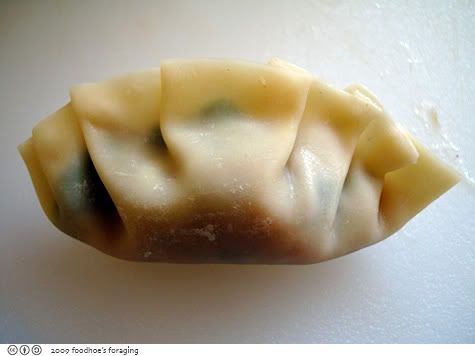
WASHOKU: Recipes from the Japanese Home Kitchen, Ten Speed Press 2005 (© 2005 All rights reserved by Elizabeth Andoh)
Makes 20 to 24 dumplings
filling:
- 2-inch piece leek, about 1/2 ounce, chopped
- 1 large leaf of cabbage, including thick stem portion, about 1/4 ounce, shredded
- 1/4 cup dried wakame bits
- 6 ounces ground pork
- 1 tablespoon grated carrot
- 1 tablespoon sake
- 1 teaspoon dark miso
- 2 teaspoons sesame oil (goma abura)
dipping sauce:
- 2 to 3 tablespoons soy sauce
- 1 to 2 tablespoons rice vinegar
Place the leek, cabbage and wakame in the bowl of a food processor and pulse-process until the mixture is finely minced. The dried wakame will pick up moisture from contact with the other vegetables and begin to soften.
Transfer the vegetable mixture to a deep bowl, and add the pork, sake, miso, and a drop or two of the sesame oil. Knead the mixture with your hands to ensure even distribution. Gather the meat mixture into a ball, lift and throw it back with force into the bowl, repeating this action 4 or 5 times, a bit like baseball practice. This pitching tenderizes the meat, and ensures the mass will hold together. Divide the meat mixture in quarters; then sub-divide each section 5 or 6 times (one small portion will become the filling for a single dumpling). Nearby, have a small dish of cold water ready, and a flat plate on which to line up the stuffed dumplings.
Lay a dumpling wrapper on a dry surface, and place one small portion of meat in the center of it.

With fingertips moistened in water, trace a half-circle line near the edge of the wrapper. Fold the wrapper over to enclose the filling, and pinch in the center to seal the edges at that spot. Pleat the closer edge of the wrapper, to the right and left of the center, pressing it to the flat edge of the wrapper at back. Set aside the stuffed dumpling, plump meat-filled side down, pleated wrapper edge standing up. Repeat to make 20 or 24 dumplings in all.

In a skillet large enough to cook all the dumplings at once, heat a teaspoon of sesame oil over medium-high heat. Carefully line up the dumplings, side-by-side, in clusters of 5 or 6 each. Arrange them standing so that the pleats are at top and the plump, meat-filled portion is in contact with the skillet. Cook for 3 minutes, or until nicely browned. Check progress by lifting one or two dumplings by their pleated edge.
Pour in 1/4 cup of water, and when the hissing and splattering die down, drizzle in the remaining sesame oil around the inner edge of the skillet. At the same time, lower the heat to keep the liquid just at a simmer, and immediately place a lid on the skillet to trap in the moisture. This type of cooking is called mushi yaki, or "steam-searing," and ensures that the pork will be thoroughly cooked, yet moist, and succulent.
Check progress after 2 minutes. When the wrappers appear translucent and the meat is firm (check by pressing lightly with a spoon, or gently pinching with chopsticks), remove the lid, and raise the heat slightly. Continue to cook until all the water has evaporated and only the oil remains, about 2 minutes. Once you hear a sizzling sound, shake the skillet. The dumplings should slide about, most likely in clusters. If they seem to stick to the skillet, move the skillet away from the stove, and re-lid it for a moment.
Remove the dumplings, a cluster at a time, with a broad, flat, flexible spatula. Flip the dumplings so that the seared surface faces up. 5 or 6 dumplings make a single serving as an appetizer, though often twice that many will be served as a main course in a family-style meal.
Serve hot, with a dipping sauce made by stirring the soy sauce and rice vinegar together.
You can add a couple of minced cloves of garlic and some minced ginger to add some excitement to the dish, as well as chili oil to the dipping sauce if you like things spicy.




